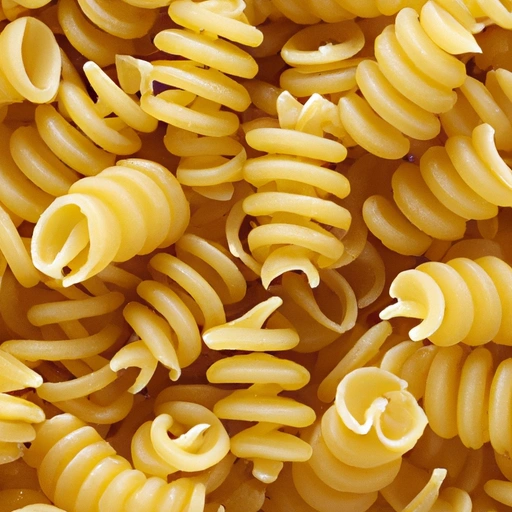Rotini
Description

Rotini is a type of helix- or corkscrew-shaped pasta that is popular in various cuisines worldwide. The spiral shape of rotini makes it excellent at holding onto sauces and seasonings, providing a delightful texture and flavor in every bite. The pasta is typically made from semolina or durum wheat, though variations include whole wheat, rice, or gluten-free options to accommodate different dietary needs. Measuring about 1.5 to 2 inches (about 4 to 5 cm) in length, rotini is versatile and can be used in a variety of dishes, ranging from cold pasta salads to hearty baked casseroles.
Common uses
Rotini is commonly used in both hot and cold preparations. It is a favorite in pasta salads, where its spirals can catch and hold onto dressings and small ingredients like chopped vegetables and herbs. Additionally, rotini is often found in baked pasta dishes, soufflés, and casseroles where its grooves are perfect for grasping onto thick, creamy sauces or hearty tomato-based sauces. Its robust structure means it holds up well during cooking, making it a preferred choice for potlucks and meals that require a bit of transportation or reheating.
Nutritional value
Calories
A 2-ounce (56-gram) serving of dry rotini pasta typically contains approximately 200 calories.
Protein
Each serving of rotini contains about 7 grams of protein, making it a substantial contributor to daily protein intake.
Fat
Rotini pasta is generally low in fat, with a serving containing less than 1 gram of fat.
Carbohydrates
The carbohydrate content in a serving of dry rotini is around 42 grams, which provides energy and is a staple of many diets.
Vitamins
Rotini can contain varying amounts of B vitamins, especially when it's enriched pasta. These vitamins are crucial for energy metabolism and maintaining healthy nervous system functions.
Minerals
Depending on the type, rotini pasta can be a source of iron and magnesium, important for blood health and muscle function, respectively.
Health benefits
Rotini pasta, especially whole wheat varieties, can be part of a healthy diet. It provides a source of complex carbohydrates necessary for energy. The fiber in whole wheat rotini aids in digestion and can help with maintaining a healthy weight. Additionally, the protein content supports muscle repair and growth. When incorporated into a balanced diet that includes a variety of foods, rotini can contribute to overall health and well-being.
Potential risks
While rotini pasta can be nutritious, it is also dense in carbohydrates, which might not align with low-carb or ketogenic diet plans. Also, traditional pasta contains gluten, making it unsuitable for those with celiac disease or gluten sensitivities. However, gluten-free alternatives made from rice or corn are available. Overconsumption of pasta may lead to weight gain, so it is recommended to enjoy rotini as part of a balanced diet.
Common recipes
Rotini is common in dishes such as pasta primavera, pasta alfredo, rotini with marinara sauce, and Mediterranean pasta salad. It is also frequently used in minestrone and other hearty soups.
Cooking methods
Rotini is typically boiled in salted water for about 8-10 minutes or until al dente. It can also be baked in casseroles or used in stir-fries for an unconventional twist.
Pairing with other ingredients
Rotini pairs well with a variety of ingredients, including fresh vegetables, rich cheeses, lean proteins such as chicken or shrimp, and robust, flavorful sauces like pesto or bolognese. Fresh herbs and spices can further complement the pasta's texture and flavor.
Summary
Rotini is a versatile and widely loved pasta shape known for its spiral grooves that are perfect for capturing sauces and seasonings. With roots tracing back to Italy, this pasta has become a global favorite, easily adaptable to a range of culinary styles and dietary preferences. Whether served in a cold pasta salad, baked into a comforting casserole, or swimming in a savory soup, rotini brings texture, flavor, and nutrition to the table. It offers a source of energy through its carbohydrates, as well as protein and minerals, contributing to a well-rounded diet when consumed in moderation.